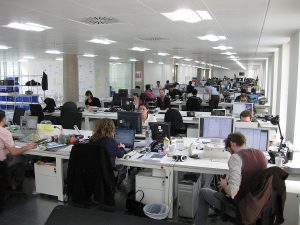
How the Pandemic Left Offices Empty Across the US
Introduction
Hello, I’m Kevin Kniffin, a professor of organizational behavior at Cornell University. I have been studying the impact of COVID-19 on work, workers, and the workplace of the future. In this article, I will share with you some of the insights and implications from my research and that of my colleagues from around the world.
The Rise of Remote Work
One of the most visible and dramatic effects of the COVID-19 pandemic has been the sudden and widespread adoption of remote work. Millions of workers in the US and elsewhere have been working from home since March 2020, when lockdowns and social distancing measures were imposed to contain the virus. According to a Pew survey, about one-third of workers in the US who can work from home now do so all the time.
Remote work has been facilitated by the rise of connectivity and communication technologies, such as video conferencing, cloud computing, and online collaboration platforms. Many workers and employers have reported benefits from remote work, such as increased flexibility, productivity, and work-life balance. However, remote work also poses challenges, such as isolation, communication difficulties, blurred boundaries, and cybersecurity risks.
The Future of the Office
What does the surge of remote work mean for the future of the office? Will offices become obsolete, or will they adapt and transform? There is no definitive answer to this question, as different organizations and industries may have different preferences and needs. However, some trends and scenarios can be anticipated based on the existing research and evidence.
One scenario is that remote work will become the new normal for many workers and organizations, especially those that rely on knowledge-intensive and creative tasks. This scenario implies that offices will become less relevant and more expensive, as they will require more space per worker to ensure health and safety. Some organizations may opt to reduce or eliminate their physical offices altogether, and rely on digital platforms and networks to coordinate and collaborate. This scenario could have profound implications for the urban landscape, as it could reduce the demand for office space, transportation, and services in downtown areas.

Another scenario is that remote work will be balanced with office work, as workers and organizations will seek to reap the benefits of both modes of work. This scenario implies that offices will become more flexible and hybrid, as they will accommodate different types of work and workers. Some organizations may adopt a hybrid model, where workers can choose to work from home or from the office, depending on their tasks, preferences, and circumstances. Some organizations may also use co-working spaces, where workers can share office facilities and amenities with other organizations and individuals. This scenario could have positive effects for the environment, as it could reduce the carbon footprint of commuting and office operations.
The Impact of COVID-19 on Work and Society
Beyond the question of the office, the COVID-19 pandemic has also had a broader impact on work and society. The pandemic has exposed and exacerbated the inequalities and vulnerabilities of workers and communities, especially those who are deemed essential, low-income, or marginalized. The pandemic has also highlighted the importance of social and emotional support, as well as mental health and well-being, for workers and organizations. The pandemic has also stimulated innovation and creativity, as workers and organizations have adapted and experimented with new ways of working and solving problems.
The COVID-19 pandemic has been a catalyst for change, but also a challenge for resilience. As we look ahead, we need to learn from the lessons and experiences of the past year, and prepare for the uncertainties and opportunities of the future. We need to rethink and redesign our work practices and policies, to ensure that they are more sustainable, inclusive, and human-centric. We also need to collaborate and communicate across disciplines, sectors, and boundaries, to address the complex and interrelated issues that affect work and society.
Key Points
| Topic | Summary |
|---|---|
| Remote work | Remote work has been enabled by technology and necessitated by the pandemic. It has advantages and disadvantages for workers and organizations. |
| Office work | Office work may become less prevalent or more flexible, depending on the preferences and needs of workers and organizations. It has implications for the urban landscape and the environment. |
| Work and society | Work and society have been affected by the pandemic in various ways. The pandemic has revealed inequalities and vulnerabilities, but also stimulated innovation and creativity |










